It’s been two months and a lot of miles since I updated our blog, but we didn’t have a lot to share and have been pretty busy. In a nutshell, we changed our plans to winter in New Mexico and the Southwest in general, and instead opted for……(drum roll)….the Oregon Coast! More and more as time goes by we’re drawn to this area – the pounding surf, sea stacks, marine mammals, small towns and  friendly folks all combine to draw us back. The winter weather here is mild due to being on the ocean; days are generally in the low to mid 50s, nights low to mid 40s. And yes, there’s rain – sometimes gentle, sometimes not. Bandon, the town we’re staying near, has an annual rainfall of just under 56 inches, about the same as Orlando, FL. No snow and rarely freezing temperatures are also a plus.
friendly folks all combine to draw us back. The winter weather here is mild due to being on the ocean; days are generally in the low to mid 50s, nights low to mid 40s. And yes, there’s rain – sometimes gentle, sometimes not. Bandon, the town we’re staying near, has an annual rainfall of just under 56 inches, about the same as Orlando, FL. No snow and rarely freezing temperatures are also a plus.
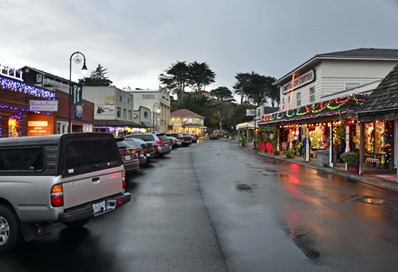 We both think Bandon is the best little town on the coast. With it’s “old town” shopping area, waterfront boardwalk, weekend market, and coffee shops and restaurants, it’s just the right combination of size and facilities.
We both think Bandon is the best little town on the coast. With it’s “old town” shopping area, waterfront boardwalk, weekend market, and coffee shops and restaurants, it’s just the right combination of size and facilities.  This year we attended the annual Christmas Parade – an action-packed eight minutes that featured two horses, three cars, one float, and a decorated tractor-trailer. But the kids seemed to enjoy catching the candy thrown by the parade their way, and they did get to see Santa, so it was all worthwhile. For adults, there was a “nog walk”; each merchant had egg nog, hot cider, or wine for sampling – all you needed was a keepsake glass purchased at one of the stores for $10.
Bandon is home to “Washed Ashore”, an amazing organization that uses plastic debris that washes up on beaches to “build aesthetically powerful art to educate a global audience about plastic pollution in oceans and waterways and spark positive changes in consumer habits”. This is particularly important to us, since as part of our state park program on Seals and Sea Lions we have a section called “Plastics, like Diamonds, are Forever”, which shows the harm that plastic rope, bags, and other discarded trash has on marine mammals and shorebirds. The staff at Washed Ashore organizes trash collection efforts, then gather volunteers, both adult and students, to build incredible works of art, which are currently on display at the Smithsonian’s Museum of Natural History. Two of their creations are on display near their center in Bandon – look close and you can see the parts of tires, bottles, and other trash that form the Puffin and Rockfish.
This year we attended the annual Christmas Parade – an action-packed eight minutes that featured two horses, three cars, one float, and a decorated tractor-trailer. But the kids seemed to enjoy catching the candy thrown by the parade their way, and they did get to see Santa, so it was all worthwhile. For adults, there was a “nog walk”; each merchant had egg nog, hot cider, or wine for sampling – all you needed was a keepsake glass purchased at one of the stores for $10.
Bandon is home to “Washed Ashore”, an amazing organization that uses plastic debris that washes up on beaches to “build aesthetically powerful art to educate a global audience about plastic pollution in oceans and waterways and spark positive changes in consumer habits”. This is particularly important to us, since as part of our state park program on Seals and Sea Lions we have a section called “Plastics, like Diamonds, are Forever”, which shows the harm that plastic rope, bags, and other discarded trash has on marine mammals and shorebirds. The staff at Washed Ashore organizes trash collection efforts, then gather volunteers, both adult and students, to build incredible works of art, which are currently on display at the Smithsonian’s Museum of Natural History. Two of their creations are on display near their center in Bandon – look close and you can see the parts of tires, bottles, and other trash that form the Puffin and Rockfish.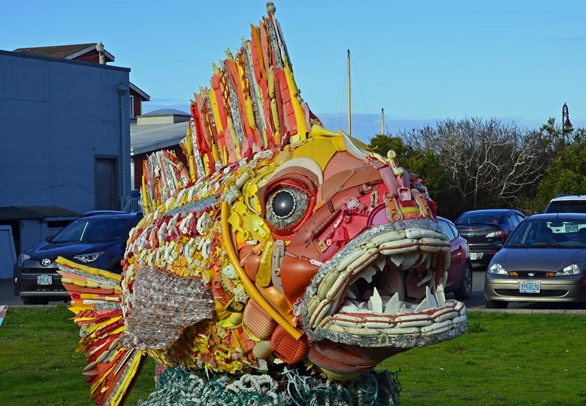

 On one of our rare sunny days, we visited Cape Arago, an area of state parks outside of Coos Bay. Here, high cliffs and offshore rocks form the perfect image for an Oregon postcard.
On one of our rare sunny days, we visited Cape Arago, an area of state parks outside of Coos Bay. Here, high cliffs and offshore rocks form the perfect image for an Oregon postcard.  Our favorite viewpoint overlooks Simpson’s Reef and Shell Island, where California Sea Lions, Steller Sea Lions, Harbor Seals, and Elephant Seals can often be seen. In the picture below, the California Sea Lions are piled atop one another, with Harbor Seals closest to the water, and a couple of Elephant Seals (the big gray ones) sleeping in the sun. The Steller Sea lions prefer to stay together, and are out of the picture on rocks to the right. We were entertained by at least five Gray Whales that were surfacing outside the rocks as they migrated south for the winter.
Our favorite viewpoint overlooks Simpson’s Reef and Shell Island, where California Sea Lions, Steller Sea Lions, Harbor Seals, and Elephant Seals can often be seen. In the picture below, the California Sea Lions are piled atop one another, with Harbor Seals closest to the water, and a couple of Elephant Seals (the big gray ones) sleeping in the sun. The Steller Sea lions prefer to stay together, and are out of the picture on rocks to the right. We were entertained by at least five Gray Whales that were surfacing outside the rocks as they migrated south for the winter. Also located along the Cape Arago highway is Shore Acres State Park, the site of a former mansion high on the cliffs. Today, all that remains are the extensive gardens that are beautiful in the summer and that become a Christmas wonderland each night. The gardener’s house is decorated and open with cookies and cider, choirs sing carols under the pavilion, and everywhere are brightly colored lights. Pelicans fly through the air, a Gray Whale “spouts”, and seals swim – an amazing scene guaranteed to put you in the Christmas spirit.
Also located along the Cape Arago highway is Shore Acres State Park, the site of a former mansion high on the cliffs. Today, all that remains are the extensive gardens that are beautiful in the summer and that become a Christmas wonderland each night. The gardener’s house is decorated and open with cookies and cider, choirs sing carols under the pavilion, and everywhere are brightly colored lights. Pelicans fly through the air, a Gray Whale “spouts”, and seals swim – an amazing scene guaranteed to put you in the Christmas spirit.

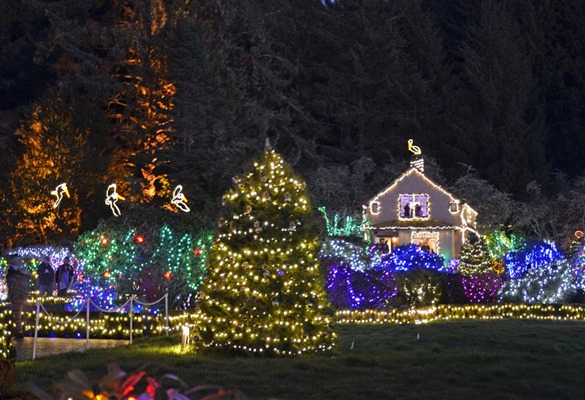



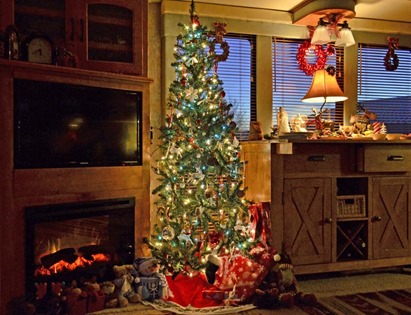 We’ve spent our Christmas in many locations in our full timing adventure, but wherever we are, we’re at home. To all of you, from the both of us, we wish you a Happy Holiday Season, a Merry Christmas, and a healthy and enriching New Year!
We’ve spent our Christmas in many locations in our full timing adventure, but wherever we are, we’re at home. To all of you, from the both of us, we wish you a Happy Holiday Season, a Merry Christmas, and a healthy and enriching New Year!
Although we’ve spent two summers in the Black Hills, we’ve never been there in the fall. We’ve always wondered what it would look like when the Aspen and Birch changed colors, and so this year we decided to find out. Our first drive was up Spearfish Canyon to the Savoy Intersection and Roughlock Falls, one of the areas used in the filming of the movie Dances with Wolves. This is an area that is spectacular on a summer day – this time of year it was absolutely magical!



Roughlock Falls is a pretty area with a rushing, crystal-clear stream, just down from where the closing scene of the movie was filmed.

 We were thrilled to have a visit from an old friend from my Air Force days. Sheryl and her mother had never been here, so the day after they toured Mount Rushmore and Crazy Horse, we took them
We were thrilled to have a visit from an old friend from my Air Force days. Sheryl and her mother had never been here, so the day after they toured Mount Rushmore and Crazy Horse, we took them 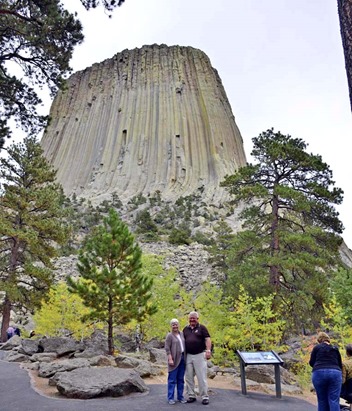 on a day trip to Devil’s Tower, Lead, and Deadwood. On the way to Devil’s Tower, we stopped for lunch in Sundance, where Sheryl and her mom had a chance to sit with the Sundance Kid. Then it was on to Devil’s Tower, one of the real wonders of the west. Even though we’ve been here before, we’re always amazed at how this strange tower erupts from the landscape. We had a great time showing our guests around – it’s always fun for us to share our knowledge of an area.
We returned to the Eastern Black Hills a few days later and were surprised at how the Aspen and Birch trees had changed. There were so many great views – here are a few:
on a day trip to Devil’s Tower, Lead, and Deadwood. On the way to Devil’s Tower, we stopped for lunch in Sundance, where Sheryl and her mom had a chance to sit with the Sundance Kid. Then it was on to Devil’s Tower, one of the real wonders of the west. Even though we’ve been here before, we’re always amazed at how this strange tower erupts from the landscape. We had a great time showing our guests around – it’s always fun for us to share our knowledge of an area.
We returned to the Eastern Black Hills a few days later and were surprised at how the Aspen and Birch trees had changed. There were so many great views – here are a few:
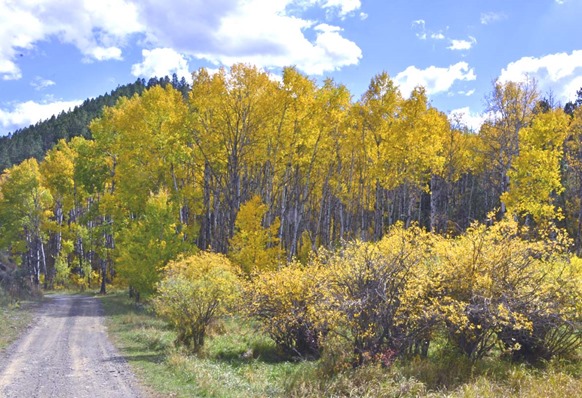
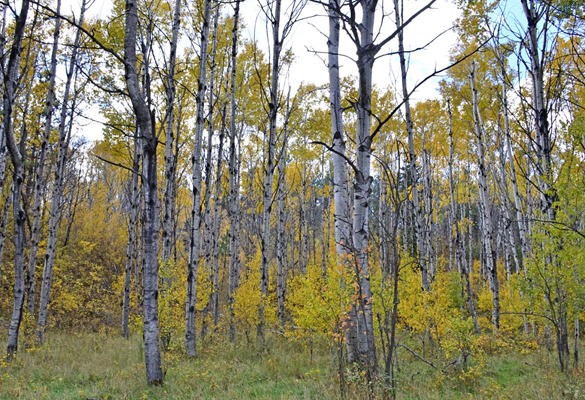

 We took the scenic route back and came through the old mining town of Lead (Leed). It’s an old town that reminds us of many of the rust-belt mining towns in Pennsylvania – narrow streets with homes built on steep slopes.
We took the scenic route back and came through the old mining town of Lead (Leed). It’s an old town that reminds us of many of the rust-belt mining towns in Pennsylvania – narrow streets with homes built on steep slopes.  As we drove down Main Street, we could see the Homestake Mine headframe. Gold was discovered here in the 1870s, and the mine became the largest and deepest gold mine in the world. Closing in 2002, the mine produced 31 million ounces of gold and seven million of silver. The mine reached an astounding depth of 8000 feet before closing, and today the Sanford Laboratory conducts “Deep Underground Neutrino” experiments near the 5000’ level. I have no idea what a ‘Neutrino” is but I think it’s good that they’re experimenting with them way, way, underground.
As we drove down Main Street, we could see the Homestake Mine headframe. Gold was discovered here in the 1870s, and the mine became the largest and deepest gold mine in the world. Closing in 2002, the mine produced 31 million ounces of gold and seven million of silver. The mine reached an astounding depth of 8000 feet before closing, and today the Sanford Laboratory conducts “Deep Underground Neutrino” experiments near the 5000’ level. I have no idea what a ‘Neutrino” is but I think it’s good that they’re experimenting with them way, way, underground.
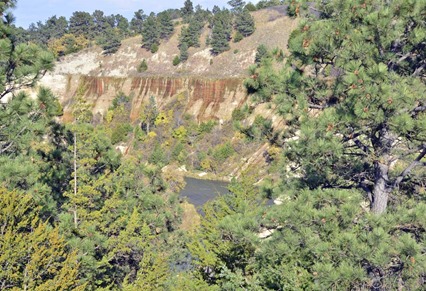 Finally it was time to leave South Dakota and head for New Mexico for the winter. We headed south to Valentine, Nebraska to visit two US Fish & Wildlife refuges, hoping that the fall migration of waterfowl and Sandhill Cranes had begun. But the warm weather has delayed the migration, so we had to be satisfied with the surprisingly beautiful scenery along the Niabrora River. But we did see Prairie Dogs – lots and lots of Prairie Dogs, madly eating to put on fat for the winter. This one doesn’t look like he needs to eat much more:
Finally it was time to leave South Dakota and head for New Mexico for the winter. We headed south to Valentine, Nebraska to visit two US Fish & Wildlife refuges, hoping that the fall migration of waterfowl and Sandhill Cranes had begun. But the warm weather has delayed the migration, so we had to be satisfied with the surprisingly beautiful scenery along the Niabrora River. But we did see Prairie Dogs – lots and lots of Prairie Dogs, madly eating to put on fat for the winter. This one doesn’t look like he needs to eat much more: During our years on the road, we’ve encountered a number of obstacles while driving; dust storms, construction, accidents, etc., but nothing like we encountered
During our years on the road, we’ve encountered a number of obstacles while driving; dust storms, construction, accidents, etc., but nothing like we encountered  entering Kansas. Cresting a hill, I looked ahead at what appeared to be a large brown mass in the road. Moving closer, we realized we were watching a cattle drive. Apparently it’s
entering Kansas. Cresting a hill, I looked ahead at what appeared to be a large brown mass in the road. Moving closer, we realized we were watching a cattle drive. Apparently it’s  easier to move the hundreds of cattle by herding them down the highway instead of trucking them. We pulled to a stop behind the herd, and were a bit surprised when the young lady on horseback motioned us to follow her.
easier to move the hundreds of cattle by herding them down the highway instead of trucking them. We pulled to a stop behind the herd, and were a bit surprised when the young lady on horseback motioned us to follow her. 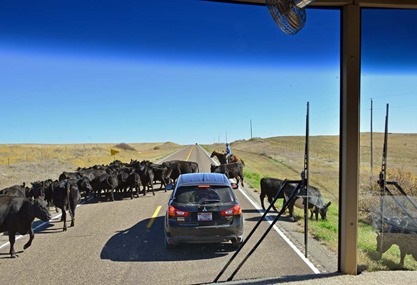 So off we went, straight through the mass of bawling, mooing, and obviously unhappy cattle. Amazingly, they moved aside as we slowly drove through, and although there were a few close calls, we managed to escape without any damage to us or the cattle. We try to stay off of the interstate highways because they’re boring – but hadn’t quite expected something like this!
And finally, we’ll leave you with this beautiful sculpture from outside the Wyoming visitor center:
So off we went, straight through the mass of bawling, mooing, and obviously unhappy cattle. Amazingly, they moved aside as we slowly drove through, and although there were a few close calls, we managed to escape without any damage to us or the cattle. We try to stay off of the interstate highways because they’re boring – but hadn’t quite expected something like this!
And finally, we’ll leave you with this beautiful sculpture from outside the Wyoming visitor center: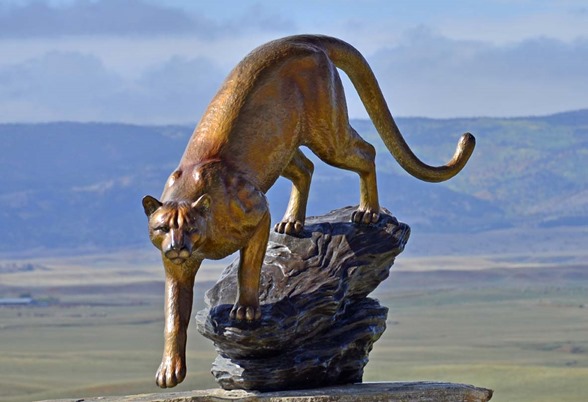 We’re in New Mexico now, and there’s always a lot to see and do here – check back and see what we’re up to!
We’re in New Mexico now, and there’s always a lot to see and do here – check back and see what we’re up to!
Leaving Michigan’s Upper Peninsula, we cut across the northern portion of Wisconsin and settled in for a stay at the not-so-attractively named Leech Lake.  The Corp of Engineers park was fantastic – one of the best parks we’ve stayed in. We relaxed, did some sightseeing, and driving around one day, crossed the Mississippi River near its headwaters. Just a quiet creek here, but driving south it didn’t take long for the river to grow into what truly looked like a river.
The Corp of Engineers park was fantastic – one of the best parks we’ve stayed in. We relaxed, did some sightseeing, and driving around one day, crossed the Mississippi River near its headwaters. Just a quiet creek here, but driving south it didn’t take long for the river to grow into what truly looked like a river. 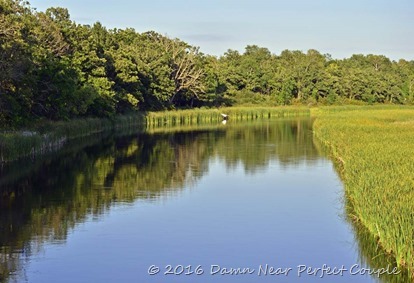 After spending time in Northern Minnesota, we realized that Minnesota, rather than the land of 10,000 lakes, is really one big lake with a lot of little islands connected by roads. Driving through the area is exhausting…..left curve, right curve, left curve – on and on as you wind your way around all of the lakes. And we had plenty of opportunity for exercise, as any trip outdoors meant waving our arms frantically to drive off the hordes of mosquitoes.
I
After spending time in Northern Minnesota, we realized that Minnesota, rather than the land of 10,000 lakes, is really one big lake with a lot of little islands connected by roads. Driving through the area is exhausting…..left curve, right curve, left curve – on and on as you wind your way around all of the lakes. And we had plenty of opportunity for exercise, as any trip outdoors meant waving our arms frantically to drive off the hordes of mosquitoes.
I n Central Minnesota, we stopped near the town of Redwood Falls and visited the Charles Lindbergh Historic Site and Museum. There was a nice museum filled with artifacts, a movie theater showing clips of his historic flight, and a flight simulator based on his aircraft. Brenda tried flying the simulator, but wasn’t too successful.
n Central Minnesota, we stopped near the town of Redwood Falls and visited the Charles Lindbergh Historic Site and Museum. There was a nice museum filled with artifacts, a movie theater showing clips of his historic flight, and a flight simulator based on his aircraft. Brenda tried flying the simulator, but wasn’t too successful.  It took a couple of 10-year olds to figure out how to work it and get airborne. Figures. The museum was informative, the house interesting, and the mosquitoes maddening. We tried to explore the city park, a large park with an overlook of….why Redwood Falls, of course. I managed a quick trip to the overlook and a picture of the falls before losing too much blood to walk, but it was close call.
It took a couple of 10-year olds to figure out how to work it and get airborne. Figures. The museum was informative, the house interesting, and the mosquitoes maddening. We tried to explore the city park, a large park with an overlook of….why Redwood Falls, of course. I managed a quick trip to the overlook and a picture of the falls before losing too much blood to walk, but it was close call. 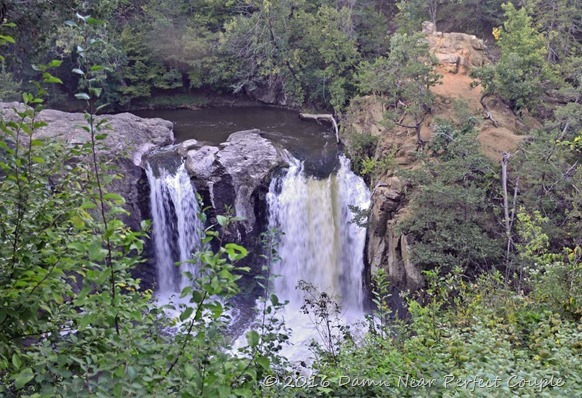 My last position in the Air Force was unusual in that I was the only male branch chief in my division, which resulted in a lot of jokes about my branch being composed of “Manly Men”. At my retirement, I was presented with a package from the “Order of Manly Men”. In it was a large beer stein with the Manly Men crest, an official certificate confirming that I was, indeed, a Manly Man. And a can of Spam, because as we know, Manly Men eat Spam. And so it was with eager anticipation that as we neared Austin, Minnesota I could at last visit the Mecca of Manly Men, the Spam Museum.
The museum is in a new building along the main street, and you’re welcomed by a statue of a farmer and his two future Spam candidates.
My last position in the Air Force was unusual in that I was the only male branch chief in my division, which resulted in a lot of jokes about my branch being composed of “Manly Men”. At my retirement, I was presented with a package from the “Order of Manly Men”. In it was a large beer stein with the Manly Men crest, an official certificate confirming that I was, indeed, a Manly Man. And a can of Spam, because as we know, Manly Men eat Spam. And so it was with eager anticipation that as we neared Austin, Minnesota I could at last visit the Mecca of Manly Men, the Spam Museum.
The museum is in a new building along the main street, and you’re welcomed by a statue of a farmer and his two future Spam candidates.  Entering the museum, you’re greeted by a happy Spam team member. The museum is large and visually stunning. As you walk around, a conveyer belt of all of the various Spam varieties moves along overhead. Ah, so many wondrous exhibits! It was difficult to decide where to go first!
Entering the museum, you’re greeted by a happy Spam team member. The museum is large and visually stunning. As you walk around, a conveyer belt of all of the various Spam varieties moves along overhead. Ah, so many wondrous exhibits! It was difficult to decide where to go first! 
 Our first stop was the Spam in Japan display, complete with a video of a commercial and enticing plastic replicas of Spam Sushi and Ramen with Spam chunks. Yumm!
Our first stop was the Spam in Japan display, complete with a video of a commercial and enticing plastic replicas of Spam Sushi and Ramen with Spam chunks. Yumm! Next we moved to Korea, again with a video of a TV commercial, and this time, displays of Spam bites, Spam spicy stew, and of course Kimchi-Spam fried rice!
Next we moved to Korea, again with a video of a TV commercial, and this time, displays of Spam bites, Spam spicy stew, and of course Kimchi-Spam fried rice!  There were many other displays – one had white work coats and hard hats for children. Kids could don the gear and sit at a workstation where their ability to assemble, stuff, and label cans of Spam was timed and displayed on a large digital clock. There was a display of WWII and how Spam was an important, if not generally enjoyed, GI food. Another displayed production numbers – 44,000 cans produced each hour, 140,000 pounds of pork shoulder used each day! And no mention of Spam would be complete without the Monty Python Spam Skit. With sixteen varieties available in the U.S. and countless other overseas, it’s no wonder that Spam is probably the most pork-based food consumed worldwide.
There were many other displays – one had white work coats and hard hats for children. Kids could don the gear and sit at a workstation where their ability to assemble, stuff, and label cans of Spam was timed and displayed on a large digital clock. There was a display of WWII and how Spam was an important, if not generally enjoyed, GI food. Another displayed production numbers – 44,000 cans produced each hour, 140,000 pounds of pork shoulder used each day! And no mention of Spam would be complete without the Monty Python Spam Skit. With sixteen varieties available in the U.S. and countless other overseas, it’s no wonder that Spam is probably the most pork-based food consumed worldwide.  After touring the museum, we visited the Spam gift shop, where hundreds of wondrous gifts could be found, from hoodies, caps, highly desired collectables…..and Spam! Once again confirming by husbandly manliness, I bought these hand-painted collectors edition pair of near priceless earrings. Seriously though folks, this was a truly worthwhile stop – if you’re in the area, put it on your list!
After touring the museum, we visited the Spam gift shop, where hundreds of wondrous gifts could be found, from hoodies, caps, highly desired collectables…..and Spam! Once again confirming by husbandly manliness, I bought these hand-painted collectors edition pair of near priceless earrings. Seriously though folks, this was a truly worthwhile stop – if you’re in the area, put it on your list! Our next stop was in our home state of South Dakota at the Randall Creek Recreation Area, a large campground along the shores of the Missouri River. We arrived at the end of a busy and crowded
Our next stop was in our home state of South Dakota at the Randall Creek Recreation Area, a large campground along the shores of the Missouri River. We arrived at the end of a busy and crowded  Labor Day weekend, and for the next few days had the park to ourselves. Next to the park is the former site of Fort Randall, established in 1863 to provide protection from Sioux tribes in the area. A large and active post, not much remains today.
Labor Day weekend, and for the next few days had the park to ourselves. Next to the park is the former site of Fort Randall, established in 1863 to provide protection from Sioux tribes in the area. A large and active post, not much remains today.  The ruins of the chapel, considered one of the largest and most beautiful on the plains, still stand under the protection of a modern roof. We walked the paved interpretive trails through the fort grounds, where descriptive displays with pictures described military life in the 1860s. Nothing really memorable here, but a beautiful setting and a beautiful day made the visit worthwhile.
We’re back in Rapid City once again before heading south next month. Hope you all enjoyed your summer – we’re looking forward to fall with its cooler temps!
The ruins of the chapel, considered one of the largest and most beautiful on the plains, still stand under the protection of a modern roof. We walked the paved interpretive trails through the fort grounds, where descriptive displays with pictures described military life in the 1860s. Nothing really memorable here, but a beautiful setting and a beautiful day made the visit worthwhile.
We’re back in Rapid City once again before heading south next month. Hope you all enjoyed your summer – we’re looking forward to fall with its cooler temps!
We’ve never spent much time in Michigan, usually just passing through the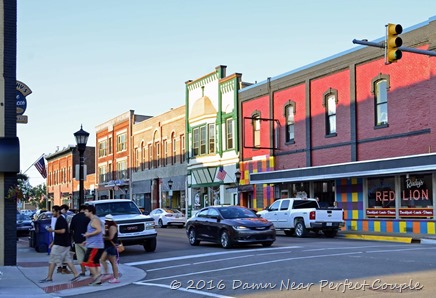 Southern border, so after leaving Ohio we decided to check out more of the state. We started with a stay in Bay City, located on the inside of the thumb on Michigan’s “Mitten”.
Southern border, so after leaving Ohio we decided to check out more of the state. We started with a stay in Bay City, located on the inside of the thumb on Michigan’s “Mitten”.  We stayed at a nice township park in Essexville, just a short drive to downtown. Brenda and I were impressed with Bay City. The main street of old homes and downtown area were impressive, and the waterfront area was nicely landscaped into a large park with bandstand and outdoor theater. Although not on the Lake Huron shoreline, the city is on the Saginaw River, which provides easy access to the lake and had a number of marinas.
We stayed at a nice township park in Essexville, just a short drive to downtown. Brenda and I were impressed with Bay City. The main street of old homes and downtown area were impressive, and the waterfront area was nicely landscaped into a large park with bandstand and outdoor theater. Although not on the Lake Huron shoreline, the city is on the Saginaw River, which provides easy access to the lake and had a number of marinas.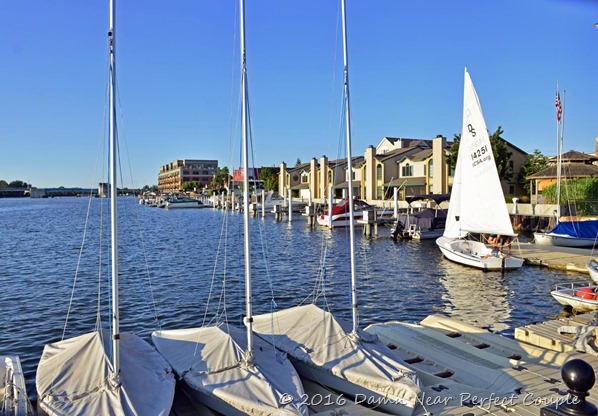
 Those of you who know Brenda know that she lives for the Christmas holidays, and so a trip to Frankenmuth and the Christmas Store was a must-do. I don’t believe I’ve ever seen a more touristy town than Frankenmuth. Everything, and I mean everything, is done in a Bavarian theme. Manicured, flowered, arranged…..if
Those of you who know Brenda know that she lives for the Christmas holidays, and so a trip to Frankenmuth and the Christmas Store was a must-do. I don’t believe I’ve ever seen a more touristy town than Frankenmuth. Everything, and I mean everything, is done in a Bavarian theme. Manicured, flowered, arranged…..if  Disneyland had a “Bavarialand”, this would be it. Our first stop was to (big surprise) a bakery in the huge Zehnder’s “Marketplace”. Spotless, large, with shelves laden with breads, rolls, cookies, and kuchen. Looking at the prices, we quickly realized that we were not only buying bakery, but buying an experience – an expensive one. But we managed to pick up a few things and head for…….The Christmas Store! Technically it’s “Bronner’s CHRISTmas Wonderland”, and billed as the largest Christmas store in the world, and after visiting, we’re convinced! Acres and acres of lights, ornaments, trees, and every Chirstmacy thing you can imagine. Thankfully, there was an ice-cream stand halfway through the place, or we’d never had made it. But rather than try and describe the place, here’s a few images:
Disneyland had a “Bavarialand”, this would be it. Our first stop was to (big surprise) a bakery in the huge Zehnder’s “Marketplace”. Spotless, large, with shelves laden with breads, rolls, cookies, and kuchen. Looking at the prices, we quickly realized that we were not only buying bakery, but buying an experience – an expensive one. But we managed to pick up a few things and head for…….The Christmas Store! Technically it’s “Bronner’s CHRISTmas Wonderland”, and billed as the largest Christmas store in the world, and after visiting, we’re convinced! Acres and acres of lights, ornaments, trees, and every Chirstmacy thing you can imagine. Thankfully, there was an ice-cream stand halfway through the place, or we’d never had made it. But rather than try and describe the place, here’s a few images:



 Leaving Bay City,
we traveled north, crossing the Mackinac Bridge and stopping at the small resort town of St. Ignace. Crossing the “Mighty Mac” bridge was a bit sporty – over 8000’ long and as much as 200’ above the water, with a nice gusty crosswind.
Leaving Bay City,
we traveled north, crossing the Mackinac Bridge and stopping at the small resort town of St. Ignace. Crossing the “Mighty Mac” bridge was a bit sporty – over 8000’ long and as much as 200’ above the water, with a nice gusty crosswind.
 Brenda, who doesn’t like high places, didn’t see much, as she had wrapped the cat around her head much like a furry scarf. Strangely, the cat didn’t seem to mind. St. Ignace proved much more comforting. Nice restaurants, great views, and lots of ferry activity back and forth to Mackinac Island. We kept hearing about this other island – Mackinaw, and thought there were two islands until we figured out that the correct pronunciation of Mackinac is “Mack-in-aw”.
From St. Ignace, it was a short trip up to Sault Ste Marie (soo-saint-marie), where we stayed in a campground with a view of the water and the huge ships that travel the Great Lakes.
Brenda, who doesn’t like high places, didn’t see much, as she had wrapped the cat around her head much like a furry scarf. Strangely, the cat didn’t seem to mind. St. Ignace proved much more comforting. Nice restaurants, great views, and lots of ferry activity back and forth to Mackinac Island. We kept hearing about this other island – Mackinaw, and thought there were two islands until we figured out that the correct pronunciation of Mackinac is “Mack-in-aw”.
From St. Ignace, it was a short trip up to Sault Ste Marie (soo-saint-marie), where we stayed in a campground with a view of the water and the huge ships that travel the Great Lakes.  The big attraction here is of course the locks. Lake Superior is connected to Lake Huron by the St. Mary’s river, but Superior is 21 feet higher and flows down an area of significant rapids near town. Before the locks, the only way to get from one to the other was to portage around, which of course wouldn’t work for large ships. And so in 1855 the first, crude but effective locks were built. In 1896 the Poe Lock was constructed followed by three more over the years. Today the Poe, rebuilt in 1968 to accommodate larger ships, and the smaller McArthur lock are the most used of the four locks built. Of the two others, one is used sparingly and the other is in caretaker status. Like the Panama Canal, the locks are operated by gravity-fed water, but unlike the Panama, there is no fee to travel through the Soo Locks. Over ten thousand ships pass through the locks each nine-month year (they’re closed during the winter) making the Soo Locks the busiest in the world.
As you can imagine, the whole town revolves around the locks. Downtown there is a beautiful park with a viewing area that puts visitors eye-level with ship’s crews, and there’s a phone line to hear the ship schedule.
The big attraction here is of course the locks. Lake Superior is connected to Lake Huron by the St. Mary’s river, but Superior is 21 feet higher and flows down an area of significant rapids near town. Before the locks, the only way to get from one to the other was to portage around, which of course wouldn’t work for large ships. And so in 1855 the first, crude but effective locks were built. In 1896 the Poe Lock was constructed followed by three more over the years. Today the Poe, rebuilt in 1968 to accommodate larger ships, and the smaller McArthur lock are the most used of the four locks built. Of the two others, one is used sparingly and the other is in caretaker status. Like the Panama Canal, the locks are operated by gravity-fed water, but unlike the Panama, there is no fee to travel through the Soo Locks. Over ten thousand ships pass through the locks each nine-month year (they’re closed during the winter) making the Soo Locks the busiest in the world.
As you can imagine, the whole town revolves around the locks. Downtown there is a beautiful park with a viewing area that puts visitors eye-level with ship’s crews, and there’s a phone line to hear the ship schedule. 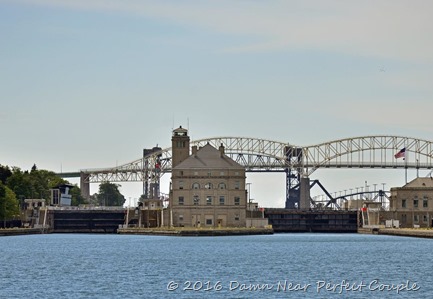 We decided to take the boat tour, and are glad we did. Leaving the dock, we headed for the locks while listening to the narrator talk about the history of the area. As we approached the locks, we were told we had to wait a bit since another tour boat was using the only operating lock and would be coming our way. Approaching the locks, we could see the gates and the administration building, built in 1896. As we waited, the gates slowly opened, the other boats left, and it was our turn to enter.
We decided to take the boat tour, and are glad we did. Leaving the dock, we headed for the locks while listening to the narrator talk about the history of the area. As we approached the locks, we were told we had to wait a bit since another tour boat was using the only operating lock and would be coming our way. Approaching the locks, we could see the gates and the administration building, built in 1896. As we waited, the gates slowly opened, the other boats left, and it was our turn to enter. We entered the locks, were tied up, and watched the gates behind us close and the water rise.
We entered the locks, were tied up, and watched the gates behind us close and the water rise.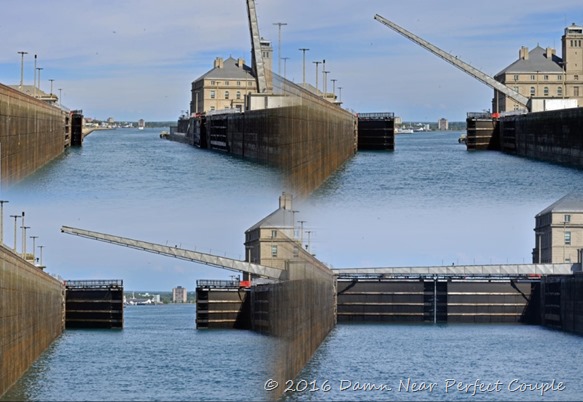
 It takes 22 MILLION gallons of water to raise a boat the 21 feet to the level of Lake Superior. It’s a good thing they don’t charge – all that water for one 65-foot boat! Entering the Lake Superior side, we cruised around for a while, and took a tour of the huge Essar Steel Algoma plant. Employing over 2800 people, it’s the 2nd largest steel plant in Canada. And is owned by India. It was actually interesting, we cruised up fairly close while the narrator told us about the steel making process and how the various ores are shipped here. And for good measure, we traded air horn greetings with some of their huge trucks.
It takes 22 MILLION gallons of water to raise a boat the 21 feet to the level of Lake Superior. It’s a good thing they don’t charge – all that water for one 65-foot boat! Entering the Lake Superior side, we cruised around for a while, and took a tour of the huge Essar Steel Algoma plant. Employing over 2800 people, it’s the 2nd largest steel plant in Canada. And is owned by India. It was actually interesting, we cruised up fairly close while the narrator told us about the steel making process and how the various ores are shipped here. And for good measure, we traded air horn greetings with some of their huge trucks.
 We returned to the locks, this time going through the smaller McArthur lock, and just as we were ready to leave, what looked like a steel island slowly came into view. Leaving the locks, we were stunned by the size of the ship – one of the ten 1000’ Great Lakes carriers. This one, the Walter J McCarthy Jr, is exactly 1000’ long with cargo capacity of over 78,000 tons.
We returned to the locks, this time going through the smaller McArthur lock, and just as we were ready to leave, what looked like a steel island slowly came into view. Leaving the locks, we were stunned by the size of the ship – one of the ten 1000’ Great Lakes carriers. This one, the Walter J McCarthy Jr, is exactly 1000’ long with cargo capacity of over 78,000 tons. As we continued down the river and back to our dock, another freighter, this one a svelte 700’ was waiting it’s turn.
As we continued down the river and back to our dock, another freighter, this one a svelte 700’ was waiting it’s turn. 
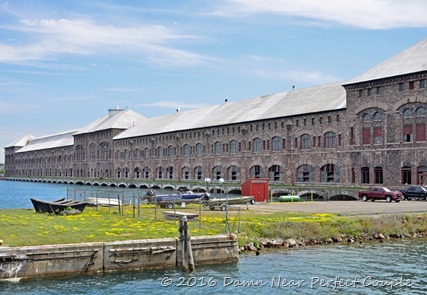 Finally we were back at the dock, next to the Edison Sault Hydroelectric Plant, in continuous operation since 1902. It’s much more than an electric plant, it’s a monument to the Italian masons who built it from local sandstone. The 1300’ long powerhouse contains 74 turbines, generating enough power to provide electricity to 25,000 homes. Impressive from a distance, a close-up shows the beautiful stone and if you look closely, you can see lighthouses spaced throughout the front of the building.
Finally we were back at the dock, next to the Edison Sault Hydroelectric Plant, in continuous operation since 1902. It’s much more than an electric plant, it’s a monument to the Italian masons who built it from local sandstone. The 1300’ long powerhouse contains 74 turbines, generating enough power to provide electricity to 25,000 homes. Impressive from a distance, a close-up shows the beautiful stone and if you look closely, you can see lighthouses spaced throughout the front of the building. From Sault Ste Marie, we headed west to the interior of the Upper Peninsula for a stay near Curtis, a small town next to Manistique Lake. We were looking for a quiet place to relax for a few days and our stay here was worthwhile. But Lake Superior called, so we journeyed to Munising to take a “shipwreck” tour boat.
From Sault Ste Marie, we headed west to the interior of the Upper Peninsula for a stay near Curtis, a small town next to Manistique Lake. We were looking for a quiet place to relax for a few days and our stay here was worthwhile. But Lake Superior called, so we journeyed to Munising to take a “shipwreck” tour boat. 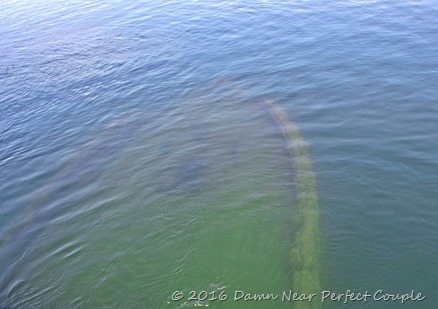 Our tour took us along the “picture rock” shoreline and two shipwrecks, one from 1870, the other from 1926. Our boat had glass panels built into the bottom for viewing, and when over the wreck, our narrator would describe what happened to the ship and what we were seeing. Our first ship’s outline was visible from the surface, thanks to the clear and cold water of Lake Superior that preserves the wrecks; after, all, this was a ship that sank almost 150 years ago! Looking through the glass panel, we could clearly see the timbers of the bow.
Our tour took us along the “picture rock” shoreline and two shipwrecks, one from 1870, the other from 1926. Our boat had glass panels built into the bottom for viewing, and when over the wreck, our narrator would describe what happened to the ship and what we were seeing. Our first ship’s outline was visible from the surface, thanks to the clear and cold water of Lake Superior that preserves the wrecks; after, all, this was a ship that sank almost 150 years ago! Looking through the glass panel, we could clearly see the timbers of the bow. The second wreck was of a larger ship and had a large amount of debris scattered along the bottom. Here’s a great view of the anchor:
The second wreck was of a larger ship and had a large amount of debris scattered along the bottom. Here’s a great view of the anchor: Leaving the wrecks, we cruised along the shore enjoying the weather and the great views. The colorful shoreline is caused by the sandstone, which erodes and leaves trees that have been undercut to grow upside-down:
Leaving the wrecks, we cruised along the shore enjoying the weather and the great views. The colorful shoreline is caused by the sandstone, which erodes and leaves trees that have been undercut to grow upside-down:
 Brenda, keeping a sharp eye out, spotted this Great Lakes Tree Shark, a rare species known for it’s tree-looking dorsal fin. Stealthy, they’re seldom seen by all but the most skilled marine observers. Like us. The rest of our fellow passengers missed this opportunity, since they were looking at this old, partially restored lighthouse.
Brenda, keeping a sharp eye out, spotted this Great Lakes Tree Shark, a rare species known for it’s tree-looking dorsal fin. Stealthy, they’re seldom seen by all but the most skilled marine observers. Like us. The rest of our fellow passengers missed this opportunity, since they were looking at this old, partially restored lighthouse.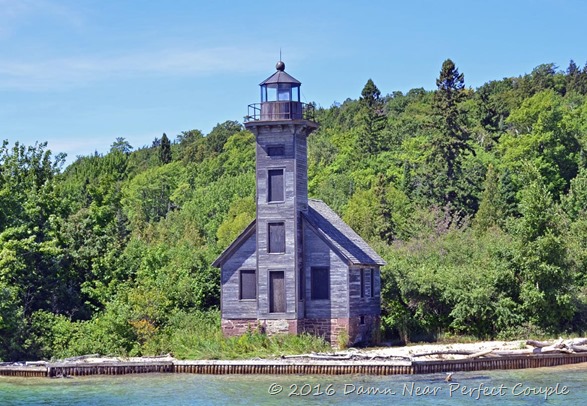 Our last trip was a shopping visit to Marquette, and then on to the former K.I. Sawyer Air Force Base, a large base that closed in 1995. While I was never stationed there, many of my friends were, and I was interested in seeing how it looked after all these years. My friends always talked about the beauty of the area, the hunting and fishing opportunities, and the harsh winters. Sadly, there not much beauty left here. Some of the base is being used by various civilian entities and most of the base housing is apparently rented out, but most of the base is empty and deteriorating. A quick tour:
Our last trip was a shopping visit to Marquette, and then on to the former K.I. Sawyer Air Force Base, a large base that closed in 1995. While I was never stationed there, many of my friends were, and I was interested in seeing how it looked after all these years. My friends always talked about the beauty of the area, the hunting and fishing opportunities, and the harsh winters. Sadly, there not much beauty left here. Some of the base is being used by various civilian entities and most of the base housing is apparently rented out, but most of the base is empty and deteriorating. A quick tour:


 Traveling around a closed base is like touring a ghost town – you wonder what life was like here when it was active. So many people spent years here, had children that grew up, and left here with fond memories. RIP, K.I. Sawyer.
That’s it for Michigan! We’re traveling again – who knows what we’ll have to share next time?
Traveling around a closed base is like touring a ghost town – you wonder what life was like here when it was active. So many people spent years here, had children that grew up, and left here with fond memories. RIP, K.I. Sawyer.
That’s it for Michigan! We’re traveling again – who knows what we’ll have to share next time?
 friendly folks all combine to draw us back. The winter weather here is mild due to being on the ocean; days are generally in the low to mid 50s, nights low to mid 40s. And yes, there’s rain – sometimes gentle, sometimes not. Bandon, the town we’re staying near, has an annual rainfall of just under 56 inches, about the same as Orlando, FL. No snow and rarely freezing temperatures are also a plus.
friendly folks all combine to draw us back. The winter weather here is mild due to being on the ocean; days are generally in the low to mid 50s, nights low to mid 40s. And yes, there’s rain – sometimes gentle, sometimes not. Bandon, the town we’re staying near, has an annual rainfall of just under 56 inches, about the same as Orlando, FL. No snow and rarely freezing temperatures are also a plus. We both think Bandon is the best little town on the coast. With it’s “old town” shopping area, waterfront boardwalk, weekend market, and coffee shops and restaurants, it’s just the right combination of size and facilities.
We both think Bandon is the best little town on the coast. With it’s “old town” shopping area, waterfront boardwalk, weekend market, and coffee shops and restaurants, it’s just the right combination of size and facilities.  This year we attended the annual Christmas Parade – an action-packed eight minutes that featured two horses, three cars, one float, and a decorated tractor-trailer. But the kids seemed to enjoy catching the candy thrown by the parade their way, and they did get to see Santa, so it was all worthwhile. For adults, there was a “nog walk”; each merchant had egg nog, hot cider, or wine for sampling – all you needed was a keepsake glass purchased at one of the stores for $10.
This year we attended the annual Christmas Parade – an action-packed eight minutes that featured two horses, three cars, one float, and a decorated tractor-trailer. But the kids seemed to enjoy catching the candy thrown by the parade their way, and they did get to see Santa, so it was all worthwhile. For adults, there was a “nog walk”; each merchant had egg nog, hot cider, or wine for sampling – all you needed was a keepsake glass purchased at one of the stores for $10. 

 On one of our rare sunny days, we visited Cape Arago, an area of state parks outside of Coos Bay. Here, high cliffs and offshore rocks form the perfect image for an Oregon postcard.
On one of our rare sunny days, we visited Cape Arago, an area of state parks outside of Coos Bay. Here, high cliffs and offshore rocks form the perfect image for an Oregon postcard.  Our favorite viewpoint overlooks Simpson’s Reef and Shell Island, where California Sea Lions, Steller Sea Lions, Harbor Seals, and Elephant Seals can often be seen. In the picture below, the California Sea Lions are piled atop one another, with Harbor Seals closest to the water, and a couple of Elephant Seals (the big gray ones) sleeping in the sun. The Steller Sea lions prefer to stay together, and are out of the picture on rocks to the right. We were entertained by at least five Gray Whales that were surfacing outside the rocks as they migrated south for the winter.
Our favorite viewpoint overlooks Simpson’s Reef and Shell Island, where California Sea Lions, Steller Sea Lions, Harbor Seals, and Elephant Seals can often be seen. In the picture below, the California Sea Lions are piled atop one another, with Harbor Seals closest to the water, and a couple of Elephant Seals (the big gray ones) sleeping in the sun. The Steller Sea lions prefer to stay together, and are out of the picture on rocks to the right. We were entertained by at least five Gray Whales that were surfacing outside the rocks as they migrated south for the winter.






 We’ve spent our Christmas in many locations in our full timing adventure, but wherever we are, we’re at home. To all of you, from the both of us, we wish you a Happy Holiday Season, a Merry Christmas, and a healthy and enriching New Year!
We’ve spent our Christmas in many locations in our full timing adventure, but wherever we are, we’re at home. To all of you, from the both of us, we wish you a Happy Holiday Season, a Merry Christmas, and a healthy and enriching New Year!





























































